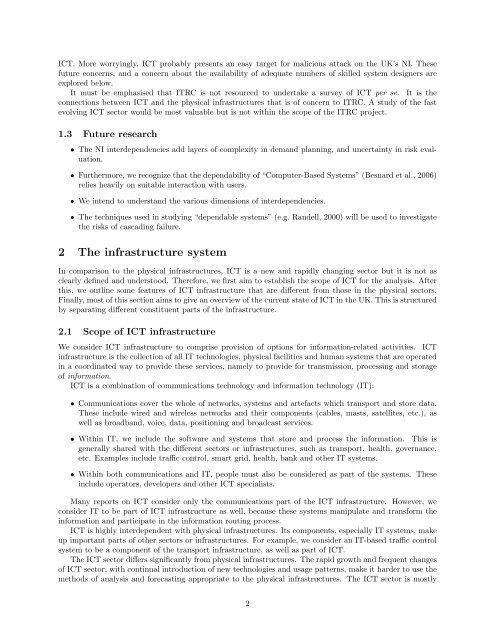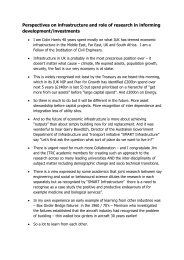A Fast Track Analysis of ICT Constraints on Evolving Physical ... - ITRC
A Fast Track Analysis of ICT Constraints on Evolving Physical ... - ITRC
A Fast Track Analysis of ICT Constraints on Evolving Physical ... - ITRC
Create successful ePaper yourself
Turn your PDF publications into a flip-book with our unique Google optimized e-Paper software.
<str<strong>on</strong>g>ICT</str<strong>on</strong>g>. More worryingly, <str<strong>on</strong>g>ICT</str<strong>on</strong>g> probably presents an easy target for malicious attack <strong>on</strong> the UK’s NI. These<br />
future c<strong>on</strong>cerns, and a c<strong>on</strong>cern about the availability <str<strong>on</strong>g>of</str<strong>on</strong>g> adequate numbers <str<strong>on</strong>g>of</str<strong>on</strong>g> skilled system designers are<br />
explored below.<br />
It must be emphasised that <strong>ITRC</strong> is not resourced to undertake a survey <str<strong>on</strong>g>of</str<strong>on</strong>g> <str<strong>on</strong>g>ICT</str<strong>on</strong>g> per se. It is the<br />
c<strong>on</strong>necti<strong>on</strong>s between <str<strong>on</strong>g>ICT</str<strong>on</strong>g> and the physical infrastructures that is <str<strong>on</strong>g>of</str<strong>on</strong>g> c<strong>on</strong>cern to <strong>ITRC</strong>. A study <str<strong>on</strong>g>of</str<strong>on</strong>g> the fast<br />
evolving <str<strong>on</strong>g>ICT</str<strong>on</strong>g> sector would be most valuable but is not within the scope <str<strong>on</strong>g>of</str<strong>on</strong>g> the <strong>ITRC</strong> project.<br />
1.3 Future research<br />
• The NI interdependencies add layers <str<strong>on</strong>g>of</str<strong>on</strong>g> complexity in demand planning, and uncertainty in risk evaluati<strong>on</strong>.<br />
• Furthermore, we recognize that the dependability <str<strong>on</strong>g>of</str<strong>on</strong>g> “Computer-Based Systems” (Besnard et al., 2006)<br />
relies heavily <strong>on</strong> suitable interacti<strong>on</strong> with users.<br />
• We intend to understand the various dimensi<strong>on</strong>s <str<strong>on</strong>g>of</str<strong>on</strong>g> interdependencies.<br />
• The techniques used in studying “dependable systems” (e.g. Randell, 2000) will be used to investigate<br />
the risks <str<strong>on</strong>g>of</str<strong>on</strong>g> cascading failure.<br />
2 The infrastructure system<br />
In comparis<strong>on</strong> to the physical infrastructures, <str<strong>on</strong>g>ICT</str<strong>on</strong>g> is a new and rapidly changing sector but it is not as<br />
clearly defined and understood. Therefore, we first aim to establish the scope <str<strong>on</strong>g>of</str<strong>on</strong>g> <str<strong>on</strong>g>ICT</str<strong>on</strong>g> for the analysis. After<br />
this, we outline some features <str<strong>on</strong>g>of</str<strong>on</strong>g> <str<strong>on</strong>g>ICT</str<strong>on</strong>g> infrastructure that are different from those in the physical sectors.<br />
Finally, most <str<strong>on</strong>g>of</str<strong>on</strong>g> this secti<strong>on</strong> aims to give an overview <str<strong>on</strong>g>of</str<strong>on</strong>g> the current state <str<strong>on</strong>g>of</str<strong>on</strong>g> <str<strong>on</strong>g>ICT</str<strong>on</strong>g> in the UK. This is structured<br />
by separating different c<strong>on</strong>stituent parts <str<strong>on</strong>g>of</str<strong>on</strong>g> the infrastructure.<br />
2.1 Scope <str<strong>on</strong>g>of</str<strong>on</strong>g> <str<strong>on</strong>g>ICT</str<strong>on</strong>g> infrastructure<br />
We c<strong>on</strong>sider <str<strong>on</strong>g>ICT</str<strong>on</strong>g> infrastructure to comprise provisi<strong>on</strong> <str<strong>on</strong>g>of</str<strong>on</strong>g> opti<strong>on</strong>s for informati<strong>on</strong>-related activities. <str<strong>on</strong>g>ICT</str<strong>on</strong>g><br />
infrastructure is the collecti<strong>on</strong> <str<strong>on</strong>g>of</str<strong>on</strong>g> all IT technologies, physical facilities and human systems that are operated<br />
in a coordinated way to provide these services, namely to provide for transmissi<strong>on</strong>, processing and storage<br />
<str<strong>on</strong>g>of</str<strong>on</strong>g> informati<strong>on</strong>.<br />
<str<strong>on</strong>g>ICT</str<strong>on</strong>g> is a combinati<strong>on</strong> <str<strong>on</strong>g>of</str<strong>on</strong>g> communicati<strong>on</strong>s technology and informati<strong>on</strong> technology (IT):<br />
• Communicati<strong>on</strong>s cover the whole <str<strong>on</strong>g>of</str<strong>on</strong>g> networks, systems and artefacts which transport and store data.<br />
These include wired and wireless networks and their comp<strong>on</strong>ents (cables, masts, satellites, etc.), as<br />
well as broadband, voice, data, positi<strong>on</strong>ing and broadcast services.<br />
• Within IT, we include the s<str<strong>on</strong>g>of</str<strong>on</strong>g>tware and systems that store and process the informati<strong>on</strong>. This is<br />
generally shared with the different sectors or infrastructures, such as transport, health, governance,<br />
etc. Examples include traffic c<strong>on</strong>trol, smart grid, health, bank and other IT systems.<br />
• Within both communicati<strong>on</strong>s and IT, people must also be c<strong>on</strong>sidered as part <str<strong>on</strong>g>of</str<strong>on</strong>g> the systems. These<br />
include operators, developers and other <str<strong>on</strong>g>ICT</str<strong>on</strong>g> specialists.<br />
Many reports <strong>on</strong> <str<strong>on</strong>g>ICT</str<strong>on</strong>g> c<strong>on</strong>sider <strong>on</strong>ly the communicati<strong>on</strong>s part <str<strong>on</strong>g>of</str<strong>on</strong>g> the <str<strong>on</strong>g>ICT</str<strong>on</strong>g> infrastructure. However, we<br />
c<strong>on</strong>sider IT to be part <str<strong>on</strong>g>of</str<strong>on</strong>g> <str<strong>on</strong>g>ICT</str<strong>on</strong>g> infrastructure as well, because these systems manipulate and transform the<br />
informati<strong>on</strong> and participate in the informati<strong>on</strong> routing process.<br />
<str<strong>on</strong>g>ICT</str<strong>on</strong>g> is highly interdependent with physical infrastructures. Its comp<strong>on</strong>ents, especially IT systems, make<br />
up important parts <str<strong>on</strong>g>of</str<strong>on</strong>g> other sectors or infrastructures. For example, we c<strong>on</strong>sider an IT-based traffic c<strong>on</strong>trol<br />
system to be a comp<strong>on</strong>ent <str<strong>on</strong>g>of</str<strong>on</strong>g> the transport infrastructure, as well as part <str<strong>on</strong>g>of</str<strong>on</strong>g> <str<strong>on</strong>g>ICT</str<strong>on</strong>g>.<br />
The <str<strong>on</strong>g>ICT</str<strong>on</strong>g> sector differs significantly from physical infrastructures. The rapid growth and frequent changes<br />
<str<strong>on</strong>g>of</str<strong>on</strong>g> <str<strong>on</strong>g>ICT</str<strong>on</strong>g> sector, with c<strong>on</strong>tinual introducti<strong>on</strong> <str<strong>on</strong>g>of</str<strong>on</strong>g> new technologies and usage patterns, make it harder to use the<br />
methods <str<strong>on</strong>g>of</str<strong>on</strong>g> analysis and forecasting appropriate to the physical infrastructures. The <str<strong>on</strong>g>ICT</str<strong>on</strong>g> sector is mostly<br />
2



